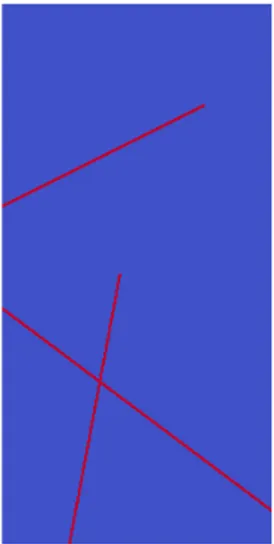HAL Id: hal-01394589
https://hal.archives-ouvertes.fr/hal-01394589
Submitted on 9 Nov 2016
HAL is a multi-disciplinary open access
archive for the deposit and dissemination of
sci-entific research documents, whether they are
pub-lished or not. The documents may come from
teaching and research institutions in France or
abroad, or from public or private research centers.
L’archive ouverte pluridisciplinaire HAL, est
destinée au dépôt et à la diffusion de documents
scientifiques de niveau recherche, publiés ou non,
émanant des établissements d’enseignement et de
recherche français ou étrangers, des laboratoires
publics ou privés.
Hybrid dimensional two phase flow in fractured porous
media
Konstantin Brenner, Julian Hennicker, Roland Masson, Pierre Samier
To cite this version:
Konstantin Brenner, Julian Hennicker, Roland Masson, Pierre Samier. Hybrid dimensional two phase
flow in fractured porous media. 13èmes Journéess d’études des Milieux Poreux 2016, Oct 2016, Anglet,
France. �hal-01394589�
Hybrid dimensional two phase flow in fractured porous media
K. Brennera, J. Hennickera,b, R. Massona, P. Samierb
aLaboratoire de Math´ematiques J.A. Dieudonn´e, UMR 7351 CNRS, University Nice Sophia Antipolis, and team COFFEE, INRIA Sophia Antipolis M´editerran´ee, Parc Valrose 06108 Nice Cedex 02, France
bCSTJF, TOTAL S.A. - Avenue Larribau, 64018 Pau, France
Keywords:
Discrete fracture models, two phase flows, fractured porous media
In this work, we extend the single phase Darcy flow model proposed in [1], [2] to two phase flow. We thus provide a model for two phase Darcy flow through discrete fracture networks (DFN) in porous media, in which the d - 1 dimensional flow in the fractures is coupled with the d dimensional flow in the matrix, leading to the so called hybrid dimensional Darcy flow model.
The model accounts for fractures acting either as drains or as barriers, since it allows pressure jumps at the matrix-fracture interfaces. The model also permits to treat gravity dominated flows as well as discontinuous capillary pressure curves at the material interfaces.
The discretization is based on an adaptation of the Vertex Approximate Gradient (VAG) and Hybrid Finite Volume schemes to this problem, in order to account for anisotropy and heterogeneity aspects as well as for applicability on general polyhedral meshes.
The numerical analysis for the single phase flow model is carried out in an extended gradient schemes framework (see [2]). In so doing, we obtain error estimates and prove convergence, which has not been achieved before for flow in complex DFN.
For two phase flow, we present several test cases including gravity and capillary effects (see Figures 1,2,3 below). The VAG scheme is used to compare our hybrid dimensional model to the hybrid dimen-sional, continuous pressure model (proposed in [3]) and to the generic equidimensional model, in which fractures have the same dimension as the matrix. This does not only provide quantitative evidence about computational gain, but also leads to deep insight about the quality of the proposed reduced model.
Figure 1: 2D test case with three fractures. The reservoir is initially saturated with water and oil is injected in the bottom fracture.
Figure 2: Oil saturation in the reservoir obtained at successive times for our reduced model and for a gravity dominant flow with the three fractures acting as drains. The capillary pressure is zero in the fractures and given by Pc(So) = −105ln(1 − So) in the matrix.
Figure 3: Oil saturation in the reservoir obtained at successive times for our reduced model and for a gravity dominant flow with the two bottom fractures acting as drains and the top fracture acting as a barrier. The capillary pressure is zero in the two bottom fractures and given by Pc(So) = −105ln(1 − So) in both the top fracture and the matrix.
References
[1] Martin, Jaffre, Roberts, Modeling fractures and barriers as interfaces for flow in porous media, SIAM J. Sci. Comput. 26 (5), pp. 1667-1691, 2005.
[2] Brenner, Hennicker, Masson, Samier, Gradient discretization of Hybrid Dimensional Darcy Flows in Fractured Porous Media with discontinuous pressures at the matrix fracture interfaces, 2015, submitted
[3] Brenner, Groza, Guichard, Masson, Vertex Approximate Gradient Scheme for Hybrid Dimen- sional Two-Phase Darcy Flows in Fractured Porous Media. ESAIM Mathematical Modelling and Numerical Analysis, 49, 303-330 (2015).

